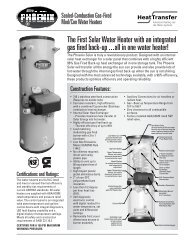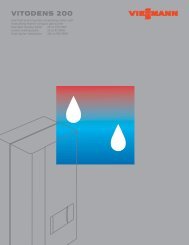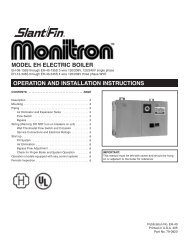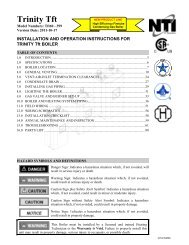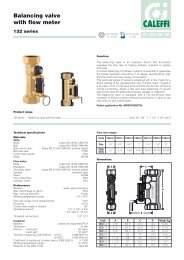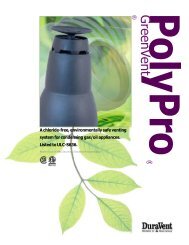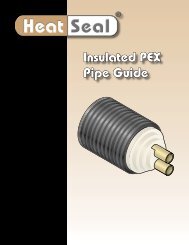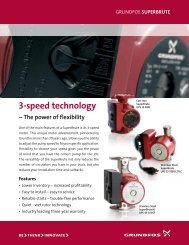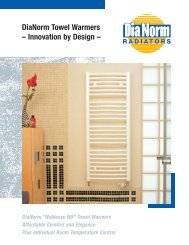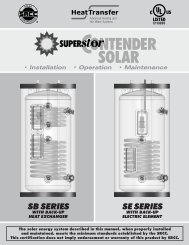Apricus Solar Water Heating System Installation and Operation ...
Apricus Solar Water Heating System Installation and Operation ...
Apricus Solar Water Heating System Installation and Operation ...
You also want an ePaper? Increase the reach of your titles
YUMPU automatically turns print PDFs into web optimized ePapers that Google loves.
<strong>Apricus</strong> <strong>Solar</strong> Collector <strong>Installation</strong> & <strong>Operation</strong> Manual - USAIn Hot regions, water will be heated from on average 63°F to 140°F = 77°F rise (17°C to 60°C = 43°C rise)3.3.3. Calculating Energy RequirementsNow that you know how much water is required <strong>and</strong> the temperature rise, you can calculate the energy required.See examples below:In Cold regions: 63 gallons with 95°F temp rise.63 gallons x 8.34 lbs of water per gallon = 525 lbs525 lbs of water x 95°F = 49,875 Btu.Assuming 15% daily tank heat loss = 57,356 Btu/day required.In Hot regions: 63 gallons with 77°F temp rise.63 gallons x 8.34 lbs of water per gallon = 525 lbs525 lbs of water x 77°F = 40,425 Btu.Assuming 15% daily tank heat loss = 46,490 Btu/day required.3.3.4. Calculating Collector Size RequirementBased on the energy requirement calculated above, an estimation of the number of collectors can be made.a) To calculate the output of the solar collector to match the household/application requirements a complexcalculation can be completed, but in most cases the the following basic guide can be used. These valuesare based on SRCC data for the <strong>Apricus</strong> collectors, (See Appendices 4-7), <strong>and</strong> based on <strong>Apricus</strong>’s actualfield observations of output.Thous<strong>and</strong>s of BTU Per Panel Per DayCategory Clear Day Mildly Cloudy Cloudy DayoA (-9 F) 46.1 34.8 23.5oB (9 F) 44.0 32.7 21.4oC (36 F) 40.6 29.3 18.0oD (90 F) 34.2 23.0 11.8oE (144 F) 27.1 16.8 6.2Cold region = Average of Clear Day B, C & D <strong>and</strong> Mild Cloudy B, C & D categories = 33.9 kBtu = 9.9kWhMild region = Average of Cold region <strong>and</strong> Hot region values = 36.75 kBtu = 10.75kWhHot region = Average of Clear Day B, C & D categories = 39.6 kBtu = 11.6kWhThe actual daily output will vary based on many factors, including the installation angle, solar radiationlevels, ambient temperature <strong>and</strong> hot water usage patterns. Given that collectors come in multiples of 10tubes a rough estimate is usually sufficient. A system should be sized to provide 90% contribution in thesummer, which normally corresponds to about 60%, 70% & 80% annual contribution for Cold, Mild <strong>and</strong> Hotregions respectively.b) Based on the requirements from the examples given in 3.3.3, an appropriate collector size can bedetermined.Cold climate: 57.35 kBtu/day required. 30 tubes averages 33.9 kBtu/day57.35 kBtu / 33.9 kBtu = 1.7 x 30 tubes is necessary to make up the difference. Therefore, a 30 tubecollector plus 20 tubes (or 50 tubes total) will provide nearly all of the summer hot water requirementsfor this household <strong>and</strong> ~60% of annual requirements. Alternatively, a good option might be 60 tubeswith the collector angle raised to about 50-60° in order to maximize winter output <strong>and</strong> minimizesummertime potential for overheating.Hot climate: 40.43 kBtu/day required. 30 tubes averages 39.6 kBtu/day40.43 kBtu / 39.6 kBtu = (about) 1. So an AP-30 would be the perfect size, providing nearly all the hotwater required in the summer <strong>and</strong> about 80% throughout the year.c) Based on similar calculations the following diagram has been developed. Only Cold <strong>and</strong> Mild regions arepresented, but they represent most regions in North America. For Hot regions, more people can be servedby the same sized system as shown for Mild regions.Copyright 2011 – <strong>Apricus</strong> Inc Doc: A7-05.4.1.4-PB-1.9 Page 15 of 126



